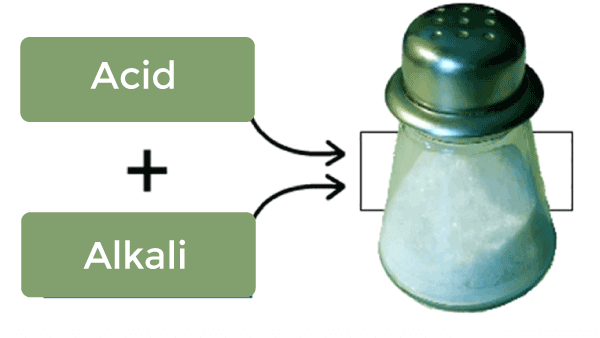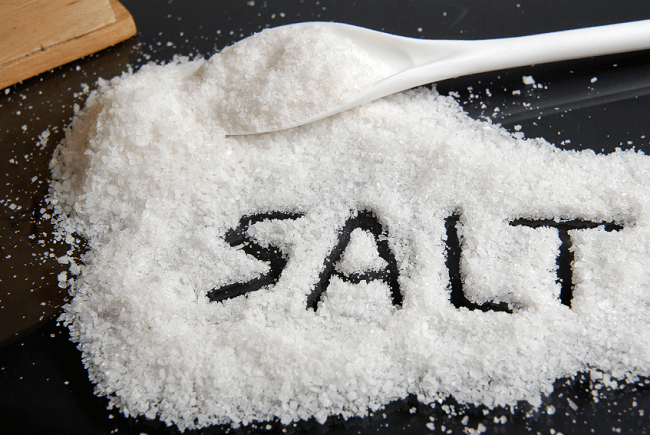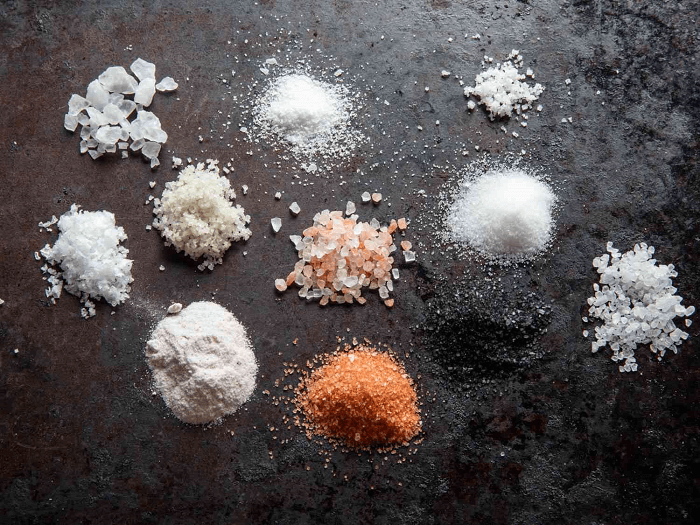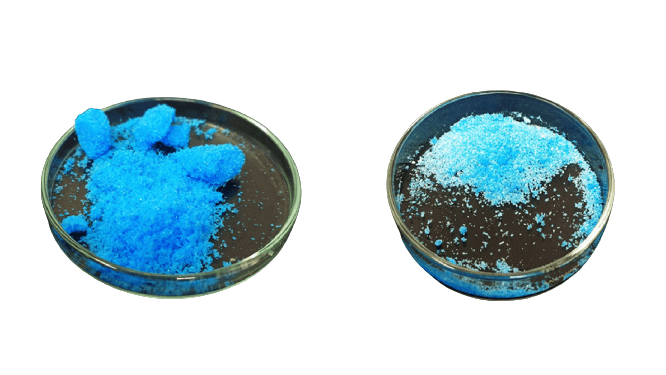Salt DefinitionA carbon atom that contains one cation (positively charged) and one anion (negatively charged) is known as salt. Salt is an essential component found in seawater in large quantities. Salts are naturally occurring solid compounds available in their pure form. It can be categorized as an ionic compound because it has a cation of acid and an anion of the base. 
Salts are the products of the neutralized reaction between acids and bases. The ionic bonding between sodium and chloride ions leads to the formation of Sodium chloride salt. The term 'salt' is most commonly known for the chemical compound sodium chloride (NaCl), representing a 1:1 ratio of sodium and chloride ions. Properties of Salts

Note- It is a dangerous substance that must be stored in cold surroundings. If it comes in contact with acidic substances, it can produce toxic fumes of chlorine.Origin of Salt (NaCl)
Types of SaltsSalts are categorized into five major types, such as: 
1. Acidic SaltsThe salts that are formed by the neutralization of strong acid and a weak base are known as acidic salt. In other words, salts that are produced through the partial neutralization of polybasic (compounds that donate more than one proton per acidic molecule) are acidic salts. During the formation of acidic salts, H+ ions that mostly act as an anion are iodized with another cation. An example of acidic salt is ammonium chloride (NH?Cl), which is produced through the neutralization reaction (given below) between aqueous ammonia and hydrogen chloride (a strong acid). NH3 + HCl -> NH4Cl 2. Alkali SaltsThe salts that are produced by the incomplete reaction between a strong base and a weak acid are known as alkali salts. In this reaction, the hydrolysis of the basic solution produces the salt. These salts are not neutral in nature and show basic properties. Alkali salts are beneficial for purposes such as industrial cleaning and preserving food items. Examples of alkali salts are potassium hydroxide and sodium hydroxide. 3. Double SaltThe salts composed of more than one anion or cation are known as double salts. These salts are formed by the mixing of two salts that are crystallized in the common regular ionic lattice. An example of double salt is Mohr's salt, also known as ammonium iron (II) sulfate, which is comprised of ammonium sulfate and ferrous sulfate. It is used as a laboratory reagent that helps form crystals. Other instances of double salts are potash alum, alstonite, carnallite, and dolomite. 4. Mixed SaltThe salts that are constituted of a fixed proportion of salts and mostly share an anion or a cation with one another are known as mixed salts. These salts contain more than one basic radical or acidic radical. The crystallization of mixed slats is a slow process and produces a mixture of a saturated solution. Mixed salts are usually available in the form of cubes, and these are used for treating ADHD (Attention-deficit/hyperactivity disorder) patients. 5. Complex SaltsA compound that is comprised of a central metal atom that forms coordination bonds with ligands surrounding it is known as complex salt. The cations and anions in these compounds bond with each other forming a complex structure. The saturated solutions of two different salts are mixed with each other before the final solution gets crystallized to produce mixed salts. Examples of complex salt solids are sodium potassium ferrocyanide and potassium argentocyanide. Hydrolysis of SaltsWhen the salt is formed as an ionic compound, the acidic and alkaline radicals neutralize each other. The solution that is formed as a product seems like it is neutral. However, in most cases, they are either acidic or basic in character. A reaction in which an ion that is present in salt reacts with water to produce an acidic or basic solution as a product is known as salt hydrolysis. It is the reverse reaction of the neutralization process. 
Hydrolysis of Weak Acids and Strong BasesWhen a weak acid such as hydrofluoric acid is combined with a strong base such as sodium hydroxide, a salt called sodium fluoride is produced along with water. In the neutralization reaction, sodium ion acts as a spectator ion because sodium fluoride is soluble in water. The fluoride ion that functions as a weak base reacts with water and accepts a proton. The hydroxide ion is produced as a product of this reaction, and therefore, the solution that is produced at last is basic in nature. Hydrolysis of Strong Acids and Strong BasesThe salts that are formed by the neutralized reaction between a strong acid and a strong base are of neutral character because, in the salt solution, bonds cannot be broken. Acidic salts mostly absorb water but do not get hydrolyzed. Hence, these salts are characterized as neutral salts. For example- Sodium chloride is the product of a strong acid (HCl) and a strong base (NaOH) neutralization reaction. Hence, it is neutral in nature. For hydrolysis to take place, one of the reactants or both reactants should be weak. Therefore, sodium chloride, which is a neutral salt, does not undergo hydrolysis and doesn't show any reaction with water. Hydrolysis of a Weak Acid and Weak BaseSalts that are formed by the combination of weak acids and weak bases can be acidic, basic, or neutral based on the reactants used in their formation. After hydrolysis, if the dissociation constant of one product is higher than the dissociation constant of another, the final solution might show the properties of the one that is stronger in nature (acidic or basic). Examples 1. Hydrolysis of salt formed by combining weak acid with the weak base when the end product is basic due to its higher dissociation. Let's take the hydrolysis of ammonium cyanide (NH4CN) as an example: NH4 + CN- + H2O -> NH4OH + HCN The dissociation constant of HCN (weak acid) is less than that of NH4OH (a weak base). Hence, the solution would show the properties of a base than an acid after hydrolysis. 2. Hydrolysis of salt formed through weak acid and weak base when the end product is more acidic than basic. In this case, let's take the hydrolysis of ammonium fluoride (NH4F) as an example: NH4 + F- + H2O -> NH4OH + HF The dissociation constant of acidic HF (7.2 x 10-4) is greater than that of a basic NH4OH (1.8 x 10-5). Therefore, the solution shows the properties of acid rather than the base. 3. Hydrolysis of salt formed by combining weak base and weak acid with the same dissociation energy. In this case, hydrolysis of ammonium acetate will display the required results. CH3COO- + NH4+ + H2O -> CH3COOH + NH4OH The dissociation constants of aqueous CH3COOH and NH4OH are almost equal. Therefore, the solution obtained after the hydrolysis would show a neutral character. Hydrolysis of Weak Bases with Strong AcidsAfter the neutralization of the weak base with strong acid, the solution shows acidic properties. For example- NH4Cl is formed by the combination of NH3 (a weak base) and HCl (strong acid). Ammonia accepts a proton from other hydrogen atoms and partially dissociates in water. Therefore, an acidic solution is yielded as a product. NH4Cl -> Cl- + NH4+ Hydrolysis of NH4+ ion NH4+ + H2O -> NH4OH + H+ Ammonium hydroxide and hydrogen ions are formed when ammonium ions undergo hydrolysis. Ammonium hydroxide is a weak base. Therefore, it does not get ionized. On the other hand, due to the high concentration of H+ ions, the solution would show an acidic character. However, its pH would be less than 7. Uses of SaltsSalts are used for many purposes due to their properties. Some of the major salts, their properties, and their uses are mentioned below: 1. Sodium Carbonate (Na2CO3. 10H2O)Uses
2. Sodium Bicarbonate (NaHCO3)
Uses
3. Sodium Chloride (NaCl)
Uses
4. Hemihydrate Calcium Sulphate (CaSO4. ½ H2O)
Uses
5. Calcium Chloride (CaCl2)
Uses
6. Calcium hypochlorite [Ca (ClO)2]
Uses
Next TopicWound Definition
|
 For Videos Join Our Youtube Channel: Join Now
For Videos Join Our Youtube Channel: Join Now
Feedback
- Send your Feedback to [email protected]
Help Others, Please Share










